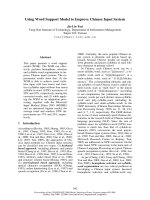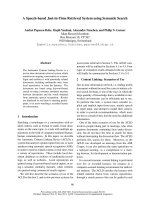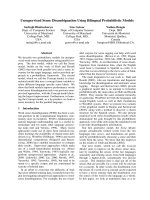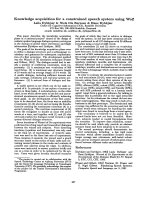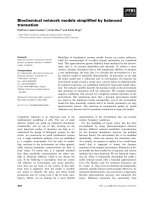Tài liệu về mô hình bướm ga điện tử sử dụng mạng CAN (Tài liệu tiếng anh)
Bạn đang xem bản rút gọn của tài liệu. Xem và tải ngay bản đầy đủ của tài liệu tại đây (761.72 KB, 20 trang )
Table of Contents
List of Abbreviated words and Figures
1. List of Abbreviated words
ECT: Electronic Control Throttle
CAN: Controller Area Network
ECU: Electronic Control Unit
SAE: Association of American Automotive Engineers
ECM: Electronic control module
TCM: Transmission control module
BCM: Body control module
ABS: Anti-block braking system
ESP: Electronic stability programming
2. List of Figures
• Figure 1. How does ECTs work
• Figure 2: Can protocol
• Figure 3: Front View of the Arduino Uno R3
• Figure 4: Front View of the Arduino Nano
• Figure 5: MCP2515 Module
• Figure 6: Throttle body model
• Figure 7: Motor SG90
• Figure 8: Arduino software
• Figure 9: Simulation ECT system model by Proteus
• Figure 10: Real ECT system model
•
•
•
•
•
•
•
•
•
Chapter 1: INTRODUCTION ABOUT OVERVIEW OF TOPIC
1.1 Domestic and foreign research situation
Electronic throttle control (ETC) system has worked its way to becoming a
standard subsystem in most of the current automobiles as it has contributed much
to the improvement of fuel economy, emissions, drivability and safety.
In view of a recent massive auto recalls due to the controversial uncontrollable
engine accelerations, this topic may inspire further research interest on the
automotive technology in the future.
There are many Domestic and foreign research on this topic.
1.1.1 Domestic
PGS.TS Đỗ Văn Dũng – Trang bị điện & điện tử trên ô tô hiện đại – Nhà xuất bản
Đại Học Quốc Gia TP. Hồ Chí Minh – Năm 2004.
Điều khiển bướm ga điện tử trên xe ô tô (Electric throttle Control) – K.s Đinh
Trường Sơn. Đại Học Công Nghệ, TP. Hồ Chí Minh – Năm 2016.
Nghiên cứu thiết kế chế tạo mạch điều khiển bướm ga, KS. Lý Vĩnh Đạt, Trường
Đại Học Sư Phạm Kỹ Thuật, Tp. Hồ Chí Minh – Năm 2005.
1.1.2 Foreign
CAN bus applied to the vehicle throttle
controller Computer Network Applications. Langfang
Teachers College Institute of Mathematics and Information Science,Hebei Langfang,China
Electronic Throttle Control System: Modeling, Identification and Model-Based
Control Designs Robert N. K. Loh1, Witt Thanom1,2, Jan S. Pyko1,2, Anson
Lee1,2 Center for Robotics and Advanced Automation, Department of Electrical
and Computer Engineering
Electrical & Electronic Systems Engineering, Chrysler Group LLC, Auburn
Hills, USA, 2013
-Electronic throttle control - Delphi Automotive Systems and Hitachi Automotive
Products. Andreas Pechlaner, Hermann Kern, Frank Auer - Throttle Control with
Smart Power Bridges and Microcontrollers of the C500 and the C16x-families –
1999.
1.2 The necessary of topic
Electronic throttle control system is more equipped in modern cars.
Throttle control by wire have become stably and accurately, so electronic throttle
control system has replaced traditional throttles which has been controlled by
cable.
In comparison with the conventional cable version, electronic throttle control
system has some advantages such as: minimum adjustment and maintenance,
absolute minimum harmful exhaust emissions cause pollution of surrounding
environment.
1.3 The objective of topic
The application of automatic control technology to automobiles instead of
mechanical control devices is inherently inaccurate and requires regular repair and
maintenance.
Replacing electronic control systems, which gives cars a number of advantages in
control, repair, maintenance and above all, the control by accurate electronic
systems and stable has helped cars emit less toxic waste causing environmental
pollution, fuel economy and control each mode of operation on the car ...
Electronic throttle control system Electronic Throttle Control System is a superior
system and has been fitted on most modern cars today.
Electronic throttle control circuit meets the dynamic requirements of throttle, in
addition to basic control functions such as conventional throttle control, electronic
throttle control circuit also combined control of modes. Cruise control and
Traction control with high accuracy and responsiveness.
1.4 Method and research area
Electronic throttle control is programmed by Adruino and applies Can-Bus
communication. Conducting research and manufacture of simulation model of
electronic throttle operation in reality. The objective is to control the opening and
closing angle of the throttle in the engine. Perform experiments.
Making premise for research, design and manufacture of electronic throttle control
system.
Electronic throttle control circuit has been designed on the basis of:
•
Use the Volume Resistor to simulate the accelerator pedal position sensor.
Simulate the change in throttle position and the signal will be sent to the ECU.
•
Adruino will tissue for ECU receive input signal of throttle position sensor,
process information and output signal to control throttle opening angle.
•
Using simulation servo motor for electronic throttle, receive signals from ECU
and perform opening and closing.
1.4.1 The method to solve problem
The signal from the throttle pedal sensor is sent to the microcontroller, the
microcontroller sends an output signal to control the throttle motor's rotating
power circuit.
At the same time, there is a feedback signal from the throttle position sensor so
that the microprocessor makes a comparison to control the throttle wings more
accurately.
In addition, when there are control signals sent by Cruise control or Traction
control, the microcontroller also controls the throttle corresponding to those
modes.
Analog signals from throttle position sensors and throttle pedal position sensors
are converted by the converter into digital signals before sending them to the
microcontroller.
1.4.2 Research area
Andreas Pechlaner, Hermann Kern, Frank Auer - Throttle Control with Smart
Power Bridges and Microcontrollers of the C500 and the C16x-families – 1999.
Electronic throttle control - Delphi Automotive Systems and Hitachi Automotive
Products.
Nghiên cứu thiết kế chế tạo mạch điều khiển bướm ga, KS. Lý Vĩnh Đạt, Trường
Đại Học Sư Phạm Kỹ Thuật, Tp. Hồ Chí Minh – Năm 2005
Chapter 2: THEORETICAL FOUNDATIONS
2.1 Overview of the electronic throttle control system position in automotive
industry
Today, science and technology is growing rapidly. Therefore, new technologies and
innovations are constantly being launched to serve industries, which create products that
make life more convenient. Especially in the automotive industry, technology is
indispensable, everything must be coordinated in a smooth and accurate way to give the
driver a feeling of comfort and without much effort and can save fuel. That is why when
the electronic throttle control system came into being, it caused a great buzz in the
automotive industry.
Based on geography, the automotive electronic throttle body market can be segmented
into Asia Pacific, Europe, North America, Latin America, and Middle East & Africa. Asia
Pacific is a prominent producer of electronic throttle body systems followed by Europe.
The automotive electronic throttle body market in Asia Pacific is estimated to expand at a
significant growth rate due to the increasing number of the vehicles manufactured in the
region.
Key manufacturers operating in the automotive electronic throttle body market are
Magneti Marelli S. p. A., Delphi Automotive PLC, Robert Bosch GmbH, Continental
AG, Denso Corporation, Jenvey Dynamics Limited, Hitachi Automotive Systems Ltd.,
and Pacco Industrial Corporation.
2.1.1 Definition of electronic throttle control system
Electronic throttle control (ETC), also known as drive-by-wire is an automobile
technology which electronically "connects" the accelerator pedal to the throttle, replacing
a mechanical linkage.
2.2 Role of electronic throttle control system
Electronic throttle control (ETC) system has worked its way to become a standard
subsystem in most of the current automobiles as it has contributed much to the
improvement of fuel economy, emissions, drivability and safety. Precision control of the
subsystem, which consists of a DC motor driving a throttle plate, a pre-loaded return
spring and a set of gear train to regulate airflow into the engine, seems rather
straightforward and yet complex.
2.3 Principle of electronic throttle control system operation
In ETC systems, a vehicle's electronic control unit uses information from the throttle
position sensor (TPS), accelerator pedal position sensor (APP sensor), wheel speed
sensors, vehicle speed sensor and a variety of other sensors to determine how to adjust
throttle position.
Figure 1. How does ECTs work
When you press on your car's gas pedal, instead of opening the throttle, you're activating
an accelerator pedal module, which converts the pressure you put on the pedal into an
electric signal. That signal is then sent to an electronic control unit, which takes your
inputs into account, as well as outside variables, to open the throttle for optimum
efficiency and performance.
Chapter 3: CAN NETWORK COMMUNICATION
3.1 Overview of CAN network communication in automotive
Communication network in particular and communication network on vehicles in
general are a system of control boxes on the same vehicle including types such as ECM,
TCM, BCM, ABS ... When operating, they can communicate and exchange information
with each other without increasing the number of wires.
In order to optimize the control and restriction of wires, today, all vehicles from cars,
trucks, tractors, construction machines, aircraft, military vehicles, even motorcycles are
also use network communication.
And CAN network is the main communication protocol used in most cars today. CAN
is used in the automobile industry, making automotive electrical systems more stable,
safe and energy-efficient, while reducing the complexity of connecting wires between
thousands of devices in the car. Researching and programming CAN system on the
communication model between CAN module and ARDUINO UNO is the most effective
approach and understanding of CAN system.
Understanding the development trend of the automobile industry, our team decided to
select the topic "Electronic Throttle Control System using CAN network" to implement
in the project plan.
3.1.1 Defination of CAN network communication
A Controller Area Network (CAN) bus is a communication system made for vehicle
intercommunication. This bus allows many microcontrollers and different types of
devices to communicate with each other in real time and also without a host computer. It
using 2 channel, CAN low and CAN high to transfer the information. CAN low will use
for normal signal which does not need to transfer fast and CAN high is use for real-time
signal.
CAN also have a protocol to communicate. When a signal is sent, it will follow
that protocol
Figure 2 : Can protocol
Out team goal is using CAN to transfer the information of the brake pedal to
control the Electric Throttle Control module.
3.1.2 History of the CAN network
CAN is a serial communication protocol that strongly supports real-time
distributed control systems with excellent stability, security, and noise resistance.
CAN has been developed by Bosch Gmbh since 1983, then officially launched in
1986 and accredited by the SAE, headquartered in Detroit Michigan.
In the first few years after its launch, Intel and Philips were the first two
manufacturers to produce chips for CAN (1987) and Mercedes-Benz W140 was the first
commercial vehicle to be equipped with CAN. Today, almost all modern cars have CAN
support and almost all major chip manufacturers in the world produce CAN integrated
chips like Siemens, Motorola, NEO, etc. Infineon, Mitsubishi, TI.
In addition to the automotive industry, CAN is also widely used in automation,
shipbuilding, submarines, agriculture, medicine ... thanks to the advantages of its
reliability.
3.2 CAN network communication method
CAN bus in automotive applications in the increasingly widespread, but the basis
of the existing bus articulated electronic throttle module, and how to make it stable and
reliable and practical, is the CAN bus, a new practical application.
3.2.1 Standard CAN protocol
The first standard of CAN is ISO 11898, which defines the characteristics of CAN,
including high-speed CAN and low-speed CAN.
3.2.2 Low speed CAN
CAN-B is defined in ISO 11898-3 and operates at a bit rate of 5 to 125kbit/s. Many
applications in vehicle body area and comfort/comfort. This speed satisfies the real-time
requirements required in this range. Examples of such applications are:
- Control the air conditioner system.
- Adjust the seat.
- Set of automatic windows.
- Control sliding doors on the roof of cars.
- Adjust the mirror.
- Light system.
- Control the steering system.
CAN bus is also used in vehicle diagnostics. Here the electronic controller is directly
connected to the CAN bus from which to receive the information it needs for instant
diagnosis. Previous diagnostic interfaces (KWP 2000) are becoming less common.
3.2.3 High speed CAN
CAN-C is defined in ISO 11898-2 and operates at speeds of 125kbit/s to 1Mbit/s.
Therefore the data transmission can satisfy the real-time requirements of the
transmission.
The CAN-C bus is used for the network of the following systems:
- Engine control system (Motronic for electronically controlled gasoline and diesel
engines).
- Control the power transmission system electronically.
- Vehicle balancing systems (ESP).
- Cluster of equipment.
3.2.4 Communication method
The feature of CAN is the method of addressingand object-oriented
communication, while most other field bus systems communicate based on the address of
the stations. Each information exchanged in the network is treated as an object, assigned
an ID number. Information sent on the bus according to the type of message transmission
may vary in length. Notifications are not sent to a specific address that any station can
receive on demand. The content of each message is distinguished by stations through an
ID code. The ID does not indicate the destination of the message, but only the meaning of
the data in the message. Therefore, each station on the network can decide whether to
receive and process messages or not to receive messages through the message filtering
method. Also by using his message filtering method, multiple stations can simultaneously
receive the same message and have different responses. A station can request another
station to send data by sending a request frame. The station that provides the information
content will return a frame containing the data with the same ID code as the request
frame. Along with the simple feature, the object-oriented communication mechanism in
CAN also provides flexibility and data consistency of the system. A CAN station does not
need to know system configuration information (eg station address). Therefore, adding or
removing a station in the network does not require any hardware or software changes at
other stations. In the CAN network, it is possible to ensure that a message is either
received by all interested stations simultaneously, or not received by any station. Data
consistency is ensured through the methods of simultaneous sending and error handling.
3.3 Advantages of ECT system using CAN network compare to traditional
communication
The use of modern vehicles ECT system with CAN bus has been completely
replaced by sensors, electronic control units and actuators and electronic control unit
between the line between the contacts, constitute the vehicle based on CAN bus control
system network. The network, including engine control, powertrain control, vehicle
control and instrumentation, such as the four functions of an independent control unit,
each control unit has its own ECU, can be run alone. There is also a control system of the
main ECU, the ECU control unit and between the main ECU to communicate through the
CAN network.
CAN allows many microcontrollers and different types of devices to communicate
with each other in real time and also without a host computer which is an advantage to
the car because car have many ECU that work in the same time. The CAN connection
also reduce the cost and weight of the car because it only use 2 wire
CHAPTER 4: DESIGN OF ELECTRONIC THROTTLE CONTROL SYSTEM
USING CAN NETWORK COMMUNICATION
The purpose of redesigning an electronic throttle control system for the experimental
engine activities was to not only learn about prototyping, controller design, and throttle
actuation, but also provide a more capable engine control system in later subjects and
graduation thesis.
This project was accomplished through the use of a microcontroller for signal processing
and command control. To cut down the price of model, we created a fake throttle and
used a microprocessor as Arduino Uno, Nano,and was entirely responsibily for signal
processing and motor control.
4.1 Introduction about hardware
4.1.1 Arduino Microcontroller: Uno R3, Nano
The Arduino Microcontrollers are the breadboard-friendly microcontroller carriers that
are commonly used in technical projects, and simple electrical engineering projects. They
are excellent candidates for using in a throttle controlling project. The board has over
twenty input/output pins that can be used for sensing and control. The boards have an
internal voltage regulator capable of producing a steady 5 and 3.3 volt supply.
Input/output pins include digital and analog signals were needed to achieve throttle angle
control. These analog input pins were used to send the user input signal and the throttle
position sensor signal to ECU.
Arduino Uno R3/ Nano datasheet:
Operating Voltage: 5 Volts
Input Voltage: 7 to 20 Volts
Digital I/O Pins: 14 (of which 6 can
provide PWM output)
Analog Input Pins: 6
DC Current per I/O Pin: 20 mA
DC Current for 3.3V Pin: 50 mA
Figure 3: Front View of the Arduino Uno R3
Flash Memory: 32 KB of which 0.5 KB used by
bootloader
SRAM: 2 KB
EEPROM: 1 KB
Figure
4: Front View of the Arduino Nano
4.1.2 Micro-controller CAN MCP2515 and module MCP2515
To program the CAN module we need to use the MCP2515 CAN Bus Controller. It is a
simple Module that supports CAN Protocol version 2.0B and can be used for
communication at 1Mbps.
In order to setup a complete communication system, you will need two CAN Bus
Module.
The following image shows the components and pins on a typical MCP2515 Module.
Figure 5: MCP2515 Module
4.1.3 Another electronic components
4.1.3a Throttle body
Figure 6: Throttle body model
The throttle body is usually located between the air filter box and the intake manifold,
and it is usually attached to, or near, the mass airflow sensor. In this project, instead of
using real throttle valve, we invent new throttle body by form and recycle material like
glass and plastic,...
Throttle body consists of a housing unit containing a throttle plate (butterfly valve) that
rotates on a shaft. When the accelerator (gas pedal) is pushed down, the throttle plate
opens and allows air into the engine
4.1.3b Servo motor SG90
It is one of the tiny and lightweight motor with high output power. This servo can rotate
approximately 180
degrees (90 in each direction), and works the same as
their types. Servo
motor SG90 is used any servo code, hardware or
library
to
control them. It comes with a 3 horns (arms) and
hardware.
Operating voltage: 4.8 V (~5V)
Operating speed: 0.1 s/60 degree
Stall torque: 1.8 kgf·cm
Dead band width: 10 µs
Temperature range: 0 ºC – 55 ºC
Figure 7: Servo motor
4.2 Introduction about software
We use Arduino 1.8.10 software. A program is designed for Arduino hardware. It is also
written in any programming language with compilers that produce binary machine code
for the target processor. Atmel provides a development environment for their 8-bit AVR
and 32-bit ARM Cortex-M based microcontrollers, while AVR Studio is older and Atmel
Studio is newer. Anyway, we need download the library for CAN BUS and install the
library to Arduino software.
To program the CAN module in adruino. First we have to declare the library, we use
mcp_can.h, SPI.h for the CAN connection. Next we setup the CAN pin with MCP_CAN
CAN (CAN pin).After that we setup the CAN bus is 500 kbps with Can.begin
(CAN_500KBPS). The final command we need are CAN.senMsgBuf and
CAN.readMsgBuf to send and read the signal from a CAN module to another CAN
module.
Figure 8: Arduino software
4.3 Modeling result
4.3.1. Simulation model
Figure 9 : Simulation ECT system model by Proteus
4.3.2 Real model
Figure 10: Real ECT system mode
4.4 Coding and explanation
4.4.1 Transmitter Module code
4.4.2 Receiver Module code
4.4.3 Check by the
Serial.print
of
program:
While,
COM3:
module
and
Transmitter module.
Receiver
COM5:
Comments and evaluation:
After
assembly
the
communication circuit between the transmitter and receive module, the result is an ECT
system controlled by CAN network.
Chapter 5: CONCLUSION AND DEVELOPMENT ORIENTATION
5.1 These achievements
Learn and know how to use the electronics board: Uno R3, Nano, Micro-controller CAN
MCP2515 and module MCP2515.
Know how to use data display software on computers such as Arduino and Proteus.
Program transmit and receive code between boards together.
Work in team.
5.2. Limitations of the topic
Time to research and research field is limited.
Lack of equipment to test.
5.3. Development orientation topic
Simulate TP sensor signals and read signals directly via CAN network.
Develop ECTS-I in future vehicle.
References
Andreas Pechlaner, Hermann Kern, Frank Auer - Throttle Control with Smart Power
Bridges and Microcontrollers of the C500 and the C16x-families – 1999.
Nghiên cứu thiết kế chế tạo mạch điều khiển bướm ga, KS. Lý Vĩnh Đạt, Trường Đại Học
Sư Phạm Kỹ Thuật, Tp. Hồ Chí Minh – Năm 2005.
CAN bus applied to the vehicle throttle controller Computer Network Applications
Langfang Teachers College Institute of Mathematics and Information Science,Hebei
Langfang,China, 065000.
Electronic throttle control Delphi Automotive Systems and Hitachi Automotive Products.
THE END!

